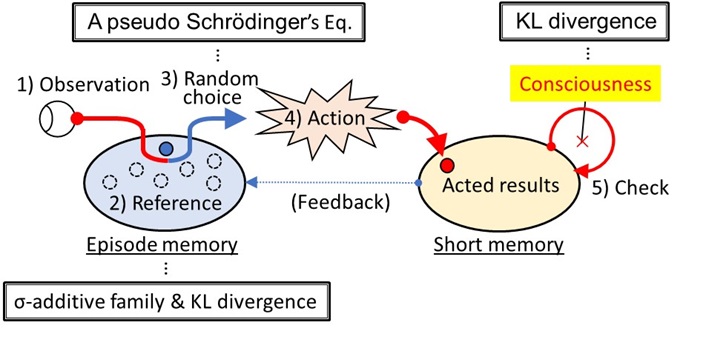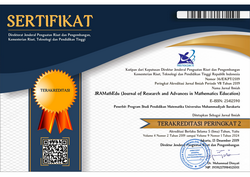Modeling of psychological time cognition with Human Language based Consciousness model
DOI:
https://doi.org/10.23917/jramathedu.v9i2.4047Keywords:
Consciousness, Mathematical model, Human language, Psychological time, Surreal numberAbstract
This paper interprets subjective psychological time in a model of consciousness called the HLbC model proposed by the authors. Time has an objective physical time and a subjective psychological time. Subjective psychological time is thought to vary in its flow depending on the individual and the situation. For this explanation, this paper introduces surreal numbers into the perception of subjective psychological time. A surreal number is a number determined from two sets of different magnitudes and contains various temporal features, including the second law of thermodynamics. By this introduction, it is shown that subjective psychological cognition is reduced to the information entropy of the present and the past by the individual or the state of each individual and depends on the state of the information entropy.
References
Albantakis, L., Barbosa, L., Findlay, G., Grasso, M., Haun, A. M., Marshall, W., Mayner, W. G. P., Zaeemzadeh, A., Boly, M., Juel, B. E., Sasai, S., Fujii, K., David, I., Hendren, J., Lang, J. P., & Tononi, G. (2023). Integrated information theory (IIT) 4.0: Formulating the properties of phenomenal existence in physical terms. PLOS Computational Biology, 19(10), e1011465. https://doi.org/10.1371/journal.pcbi.1011465
Allen, J. F. (1984). Towards a general model of action and time (23rd ed.). Artificial Intelligence.
Allen, J. F., & P.J. Hayes. (1985). A Common-Sense Theory of Time: The Longer Paper. TR Computer Science Dept, Univ. of Rochester.
Arakaki, M., Dozono, C., Frolova, H., Hebishima, H., & Inage, S. (2023). Modeling of will and consciousness based on the human language: Interpretation of qualia and psychological consciousness. Biosystems, 227–228, 104890. https://doi.org/10.1016/j.biosystems.2023.104890
Ehrlich, P. (2012). The Absolute Arithmetic Continuum and the Unification Of all Numbers Great and Small. The Bulletin of Symbolic Logic, 18(1), 1–45. https://doi.org/10.2178/bsl/1327328438
Gibbon, J., Church, R. M., & Meck, W. H. (1984). Scalar timing in memory. In J. Gibon & Allan (Eds.), Timing and time perception (423rd ed., pp. 52–77).
Gonshor, H. (1986). An Introduction to the Theory of Surreal Numbers. Cambridge University Press. https://doi.org/10.1017/CBO9780511629143
Hebishima, H., Arakaki, M., Dozono, C., Frolova, H., & Inage, S. (2023). Mathematical definition of human language, and modeling of will and consciousness based on the human language. Biosystems, 225, 104840. https://doi.org/10.1016/j.biosystems.2023.104840
Iyoda, E., Kaneko, K., & Sagawa, T. (2017). Fluctuation Theorem for Many-Body Pure Quantum States. Physical Review Letters, 119(10), 100601. https://doi.org/10.1103/PhysRevLett.119.100601
John H. Conway. (2000). On Numbers and Games (illustrated). CRC Press.
John McTaggart. (1998). Mind (17th ed.).
Kent, L., & Wittmann, M. (2021). Time consciousness: the missing link in theories of consciousness. Neuroscience of Consciousness, 2021(2). https://doi.org/10.1093/nc/niab011
Kullback, S., & Leibler, R. A. (1951). On Information and Sufficiency. The Annals of Mathematical Statistics, 22(1), 79–86.
Meck, W. H. (2005). Neuropsychology of timing and time perception. Brain and Cognition, 58(1), 1–8. https://doi.org/10.1016/j.bandc.2004.09.004
Northoff, G., & Lamme, V. (2020). Neural signs and mechanisms of consciousness: Is there a potential convergence of theories of consciousness in sight? Neuroscience & Biobehavioral Reviews, 118, 568–587. https://doi.org/10.1016/j.neubiorev.2020.07.019
Pieron, H. (1923). Les problemes Psychophysiologiques de la perception du temps (24th ed.). L’Annee Psychologique.
Pierre Janet. (1928). L’évolution de la mémoire et de la notion du temps. A. Chahine.
Tononi, G. (2004). An information integration theory of consciousness. BMC Neuroscience, 5. https://doi.org/10.1186/1471-2202-5-42
Tononi, G. (2008). Consciousness as Integrated Information: a Provisional Manifesto. The Biological Bulletin, 215(3), 216–242. https://doi.org/10.2307/25470707
Tononi, G. (2012). Integrated information theory of consciousness: an updated account. Archives Italiennes de Biologie, 150(2–3), 56–90. https://doi.org/10.4449/aib.v149i5.1388
van den Dries, L., & Ehrlich, P. (2001). Fields of surreal numbers and exponentiation. Fundamenta Mathematicae, 167(2), 173–188. https://doi.org/10.4064/fm167-2-3
Zakay, D., & Block, R. A. (1996). The role of attention in time estimation processes. In M. A. Pastor & J. Artieda (Eds.), Time, Internal Clocks and Movement (Vol. 115, pp. 143–164). North-Holland. https://doi.org/https://doi.org/10.1016/S0166-4115(96)80057-4
Zakay, D., & Block, R. A. (1997). Temporal Cognition. Current Directions in Psychological Science, 6(1), 12–16. https://doi.org/10.1111/1467-8721.ep11512604

Submitted
Accepted
Published
How to Cite
Issue
Section
License
Copyright (c) 2024 Shin-ichi Inage

This work is licensed under a Creative Commons Attribution-NonCommercial 4.0 International License.















